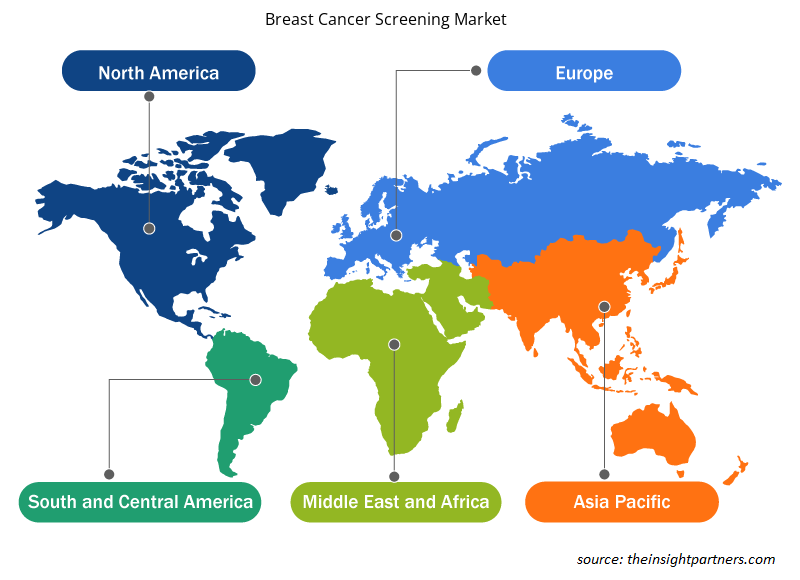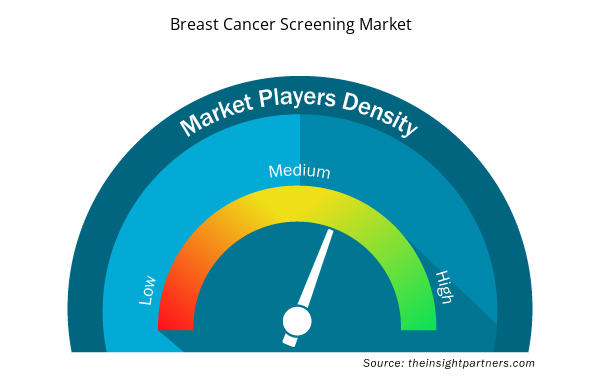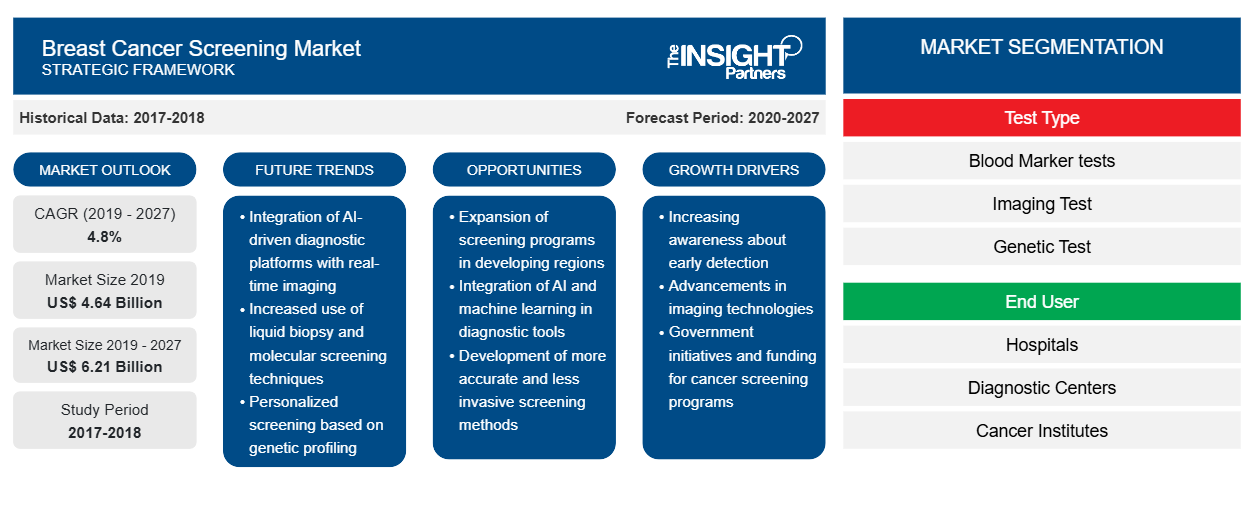[Rapporto di ricerca] Si prevede che il mercato dello screening del cancro al seno raggiungerà i 6.209,25 milioni di dollari entro il 2027, rispetto ai 4.638,63 milioni di dollari del 2019; si stima che crescerà a un CAGR del 4,8% dal 2020 al 2027.
Il cancro al seno è il tipo di cancro più comune e diffuso tra le donne; si sviluppa nei tessuti del seno, solitamente nei dotti (tubi che trasportano il latte al capezzolo) e nei lobuli (ghiandole che producono il latte). Può anche verificarsi nel tessuto adiposo o nel tessuto connettivo fibroso all'interno del seno. La diagnosi precoce del cancro al seno è importante in quanto può impedire che la condizione diventi critica e garantire un trattamento curabile di successo. I metodi di screening per la diagnosi del cancro al seno includono mammografia, risonanza magnetica per immagini (RMI), ultrasuoni e altri. L'obiettivo principale dello screening è rilevare la malattia nella sua fase più precoce e curabile. Le procedure di screening identificano i primi segni di cancro, anche prima che i sintomi inizino a manifestarsi.
Personalizza questo report in base alle tue esigenze
Riceverai la personalizzazione gratuita di qualsiasi report, comprese parti di questo report, o analisi a livello nazionale, pacchetto dati Excel, oltre a usufruire di grandi offerte e sconti per start-up e università
- Scopri le principali tendenze di mercato in questo rapporto.Questo campione GRATUITO includerà analisi di dati che spaziano dalle tendenze di mercato alle stime e alle previsioni.
Approfondimenti di mercato
Prevalenza del cancro al seno in crescita a livello globale
Il cancro al seno è una delle principali cause di morte nel mondo e sta influenzando profondamente la qualità della vita. Pertanto, agisce come un peso per la società se non diagnosticato e trattato in tempo. Secondo le stime dell'American Cancer Society, il cancro al seno è il tipo di cancro più comune negli Stati Uniti in quanto ha causato morbilità in circa 234.087 persone e ha portato a 41.904 decessi nel 2018. Inoltre, sono previsti circa 276.480 nuovi casi nel paese nel 2020. Secondo il rapporto Globocan 2019, in Germania, il numero totale di casi di cancro al seno nel 2018 è stato di 71.888 e circa la malattia ha portato a circa 19.376 decessi in quell'anno. Inoltre, secondo il rapporto Globocan, nel 2018, ci sono stati circa 367.900 nuovi casi di cancro al seno e 97.972 decessi dovuti allo stesso in Cina. In India, ONG, agenzie governative e organizzazioni di beneficenza stanno sottolineando la consapevolezza del cancro al seno tra la popolazione per promuovere la diagnosi precoce, fornire un modulo di trattamento completo ed estendere il supporto per la gestione del cancro al seno. Tali iniziative sono il risultato della crescente prevalenza di questo tipo di cancro nel paese. Secondo la stima del rapporto Globocan, nel 2018, l'India ha segnalato circa 162.468 nuovi casi di cancro al seno e 87.090 decessi dovuti allo stesso. Tale crescente prevalenza del cancro al seno in diverse regioni del mondo sta aumentando la domanda globale di dispositivi di screening per lo stesso.
Approfondimenti di mercato basati sul tipo di test
Il mercato dello screening del cancro al seno , per tipo di prodotto, è segmentato in test dei marcatori del sangue, test di imaging, test genetico, test di immunoistochimica. Il segmento dei test di imaging ha detenuto la quota maggiore del mercato nel 2019 e si prevede anche che registrerà il CAGR più elevato nel mercato durante il periodo di previsione.
Approfondimenti basati sull'utente finale
Sulla base dell'utente finale, il mercato dello screening del cancro al seno è stato segmentato in ospedali, centri diagnostici, istituti oncologici e laboratori di ricerca. Il segmento degli ospedali ha detenuto la quota maggiore del mercato nel 2019, mentre si stima che il segmento dei centri diagnostici registrerà il CAGR più elevato nel mercato durante il periodo di previsione.
Il lancio e l'approvazione dei prodotti sono una strategia comunemente adottata dalle aziende nel mercato dello screening del cancro al seno per espandere la propria presenza in tutto il mondo e soddisfare la crescente domanda ampliando i propri portafogli di prodotti. Adottano anche la strategia di espansione per ampliare la base clienti in tutto il mondo, il che consente loro anche di mantenere il proprio marchio a livello globale. Ad esempio, a giugno 2017, Siemens Healthineers ha ricevuto l'approvazione della Food and Drug Administration (FDA) per il prodotto syngo.via VB20 che probabilmente verrà utilizzato per l'imaging molecolare (MI) da Siemens Healthineers, una nuova versione del consolidato software di visualizzazione intelligente dell'azienda per l'imaging multimodale.
Approfondimenti regionali sul mercato dello screening del cancro al seno
Le tendenze regionali e i fattori che influenzano il mercato dello screening del cancro al seno durante il periodo di previsione sono stati ampiamente spiegati dagli analisti di Insight Partners. Questa sezione discute anche i segmenti e la geografia del mercato dello screening del cancro al seno in Nord America, Europa, Asia Pacifico, Medio Oriente e Africa e America meridionale e centrale.

- Ottieni i dati specifici regionali per il mercato dello screening del cancro al seno
Ambito del rapporto di mercato sullo screening del cancro al seno
| Attributo del report | Dettagli |
|---|---|
| Dimensioni del mercato nel 2019 | 4,64 miliardi di dollari USA |
| Dimensioni del mercato entro il 2027 | 6,21 miliardi di dollari USA |
| CAGR globale (2019 - 2027) | 4,8% |
| Dati storici | 2017-2018 |
| Periodo di previsione | 2020-2027 |
| Segmenti coperti | Per tipo di test
|
| Regioni e Paesi coperti | America del Nord
|
| Leader di mercato e profili aziendali chiave |
|
Densità degli attori del mercato: comprendere il suo impatto sulle dinamiche aziendali
Il mercato dello screening del cancro al seno sta crescendo rapidamente, spinto dalla crescente domanda degli utenti finali dovuta a fattori quali l'evoluzione delle preferenze dei consumatori, i progressi tecnologici e una maggiore consapevolezza dei benefici del prodotto. Con l'aumento della domanda, le aziende stanno ampliando le loro offerte, innovando per soddisfare le esigenze dei consumatori e capitalizzando sulle tendenze emergenti, il che alimenta ulteriormente la crescita del mercato.
La densità degli operatori di mercato si riferisce alla distribuzione di aziende o società che operano in un particolare mercato o settore. Indica quanti concorrenti (operatori di mercato) sono presenti in un dato spazio di mercato in relazione alle sue dimensioni o al valore di mercato totale.
Le principali aziende che operano nel mercato dello screening del cancro al seno sono:
- Koninklijke Philips NV.
- Azienda
- BD
- MYRIAD GENETICS, INC.
- SIEMENS HEALTHCARE GMBH
Disclaimer : le aziende elencate sopra non sono classificate secondo un ordine particolare.

- Ottieni una panoramica dei principali attori del mercato dello screening del cancro al seno
Mercato dello screening del cancro al seno – Per tipo di prodotto
- Test del marcatore del sangue
- Test di imaging
- Test genetico
- Test di immunoistochimica
Mercato dello screening del cancro al seno – Per applicazione
- Centri Diagnostici
- Ospedali
- Laboratori di ricerca
- Istituti oncologici
Screening del cancro al seno – Per area geografica
- America del Nord
- NOI
- Canada
- Messico
- Europa
- Francia
- Germania
- Italia
- Regno Unito
- Spagna
- Resto d'Europa
- Asia Pacifico
- Cina
- India
- Corea del Sud
- Giappone
- Australia
- Resto dell'Asia Pacifica
- Medio Oriente e Africa
- Sudafrica
- Arabia Saudita
- Emirati Arabi Uniti
- Resto del Medio Oriente e Africa
- Sud America
- Brasile
- Argentina
- Resto del Sud America
Profili aziendali
- Compagnia elettrica generale
- Siemens Healthineers Italia S.p.A.
- Società di scienze esatte
- Koninklijke Philips NV
- Azienda
- BD
- Azienda: Myriad Genetics, Inc.
- Società Oncocyte
- Danaher
- Sistemi medici POC
- Analisi storica (2 anni), anno base, previsione (7 anni) con CAGR
- Analisi PEST e SWOT
- Valore/volume delle dimensioni del mercato - Globale, regionale, nazionale
- Industria e panorama competitivo
- Set di dati Excel



Report Coverage
Revenue forecast, Company Analysis, Industry landscape, Growth factors, and Trends

Segment Covered
This text is related
to segments covered.

Regional Scope
North America, Europe, Asia Pacific, Middle East & Africa, South & Central America

Country Scope
This text is related
to country scope.
Domande frequenti
The North American region holds the largest market for the breast cancer screening. The United States held the largest market for breast cancer screening mean market and is expected to grow due to factors such as increasing number of rising in prevalence of breast cancer, growing developments for screening and imaging process by the companies and others.
The diagnosis of breast cancer is done through breast cancer screening methods such as mammography, magnetic resonance imaging (MRI), ultrasound, and others. Screening examinations are tests performed for early diagnosis of the disease. The foremost goal of screening is to detect disease at its earliest and most treatable stage.
The growth of the market is attributed to some key driving factors such as increasing number of breast cancer cases, growing geriatric population and rising adoption of technology for screening purpose. However, high cost of screening method and bassinet on global business due to coronavirus pandemic are expected to restraint the growth of the market during the forecast years.
Trends and growth analysis reports related to Life Sciences : READ MORE..
The List of Companies - Breast Cancer Screening Market
- Koninklijke Philips N.V..
- HOLOGIC, INC.
- BD
- MYRIAD GENETICS, INC.
- SIEMENS HEALTHCARE GMBH
- Exact Sciences Corporation
- ONCOCYTE CORPORATION
- POC MEDICAL SYSTEMS
- Danaher
- GENERAL ELECTRIC
The Insight Partners performs research in 4 major stages: Data Collection & Secondary Research, Primary Research, Data Analysis and Data Triangulation & Final Review.
- Data Collection and Secondary Research:
As a market research and consulting firm operating from a decade, we have published and advised several client across the globe. First step for any study will start with an assessment of currently available data and insights from existing reports. Further, historical and current market information is collected from Investor Presentations, Annual Reports, SEC Filings, etc., and other information related to company’s performance and market positioning are gathered from Paid Databases (Factiva, Hoovers, and Reuters) and various other publications available in public domain.
Several associations trade associates, technical forums, institutes, societies and organization are accessed to gain technical as well as market related insights through their publications such as research papers, blogs and press releases related to the studies are referred to get cues about the market. Further, white papers, journals, magazines, and other news articles published in last 3 years are scrutinized and analyzed to understand the current market trends.
- Primary Research:
The primarily interview analysis comprise of data obtained from industry participants interview and answers to survey questions gathered by in-house primary team.
For primary research, interviews are conducted with industry experts/CEOs/Marketing Managers/VPs/Subject Matter Experts from both demand and supply side to get a 360-degree view of the market. The primary team conducts several interviews based on the complexity of the markets to understand the various market trends and dynamics which makes research more credible and precise.
A typical research interview fulfils the following functions:
- Provides first-hand information on the market size, market trends, growth trends, competitive landscape, and outlook
- Validates and strengthens in-house secondary research findings
- Develops the analysis team’s expertise and market understanding
Primary research involves email interactions and telephone interviews for each market, category, segment, and sub-segment across geographies. The participants who typically take part in such a process include, but are not limited to:
- Industry participants: VPs, business development managers, market intelligence managers and national sales managers
- Outside experts: Valuation experts, research analysts and key opinion leaders specializing in the electronics and semiconductor industry.
Below is the breakup of our primary respondents by company, designation, and region:

Once we receive the confirmation from primary research sources or primary respondents, we finalize the base year market estimation and forecast the data as per the macroeconomic and microeconomic factors assessed during data collection.
- Data Analysis:
Once data is validated through both secondary as well as primary respondents, we finalize the market estimations by hypothesis formulation and factor analysis at regional and country level.
- Macro-Economic Factor Analysis:
We analyse macroeconomic indicators such the gross domestic product (GDP), increase in the demand for goods and services across industries, technological advancement, regional economic growth, governmental policies, the influence of COVID-19, PEST analysis, and other aspects. This analysis aids in setting benchmarks for various nations/regions and approximating market splits. Additionally, the general trend of the aforementioned components aid in determining the market's development possibilities.
- Country Level Data:
Various factors that are especially aligned to the country are taken into account to determine the market size for a certain area and country, including the presence of vendors, such as headquarters and offices, the country's GDP, demand patterns, and industry growth. To comprehend the market dynamics for the nation, a number of growth variables, inhibitors, application areas, and current market trends are researched. The aforementioned elements aid in determining the country's overall market's growth potential.
- Company Profile:
The “Table of Contents” is formulated by listing and analyzing more than 25 - 30 companies operating in the market ecosystem across geographies. However, we profile only 10 companies as a standard practice in our syndicate reports. These 10 companies comprise leading, emerging, and regional players. Nonetheless, our analysis is not restricted to the 10 listed companies, we also analyze other companies present in the market to develop a holistic view and understand the prevailing trends. The “Company Profiles” section in the report covers key facts, business description, products & services, financial information, SWOT analysis, and key developments. The financial information presented is extracted from the annual reports and official documents of the publicly listed companies. Upon collecting the information for the sections of respective companies, we verify them via various primary sources and then compile the data in respective company profiles. The company level information helps us in deriving the base number as well as in forecasting the market size.
- Developing Base Number:
Aggregation of sales statistics (2020-2022) and macro-economic factor, and other secondary and primary research insights are utilized to arrive at base number and related market shares for 2022. The data gaps are identified in this step and relevant market data is analyzed, collected from paid primary interviews or databases. On finalizing the base year market size, forecasts are developed on the basis of macro-economic, industry and market growth factors and company level analysis.
- Data Triangulation and Final Review:
The market findings and base year market size calculations are validated from supply as well as demand side. Demand side validations are based on macro-economic factor analysis and benchmarks for respective regions and countries. In case of supply side validations, revenues of major companies are estimated (in case not available) based on industry benchmark, approximate number of employees, product portfolio, and primary interviews revenues are gathered. Further revenue from target product/service segment is assessed to avoid overshooting of market statistics. In case of heavy deviations between supply and demand side values, all thes steps are repeated to achieve synchronization.
We follow an iterative model, wherein we share our research findings with Subject Matter Experts (SME’s) and Key Opinion Leaders (KOLs) until consensus view of the market is not formulated – this model negates any drastic deviation in the opinions of experts. Only validated and universally acceptable research findings are quoted in our reports.
We have important check points that we use to validate our research findings – which we call – data triangulation, where we validate the information, we generate from secondary sources with primary interviews and then we re-validate with our internal data bases and Subject matter experts. This comprehensive model enables us to deliver high quality, reliable data in shortest possible time.


 Ottieni un campione gratuito per questo repot
Ottieni un campione gratuito per questo repot